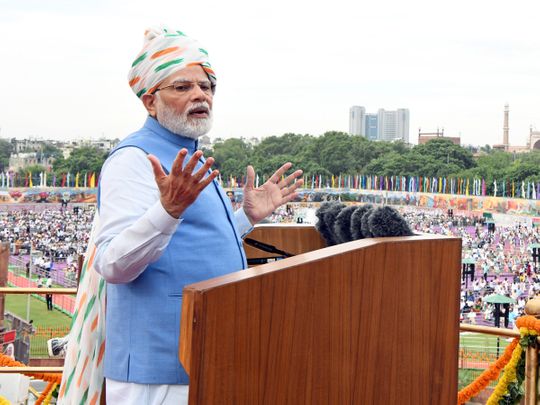
August in Delhi is hot and muggy, with the monsoons playing hide and seek with the parched land. But this year, it has rained aplenty, as if the heavens have showered their blessings on India@75 — sujalam, sufalam, blessed with flowing streams and fruitful boughs. On August 14, the eve of India’s Independence Day, Delhi’s streets were festooned with the tricolour or tiranga. With Prime Minister Modi’s call to the nation, Har Ghar Tiranga — every home a tricolour — the nation’s capital witnessed an unprecedented display of tricolour buntings and unfurling of the national flag.
It was another of Modi’s visionary initiatives, showing him as a master psychologist, political strategist, and mover of the masses. After all, who can oppose the national flag? The poorest parts of the city, even the slums and street-dwellers, proudly blazoned the national insignia. The democratisation of national symbols makes for an inclusive polity, something Modi knows very well. It instils a sense of pride and participation in the ordinary citizen.
No wonder, Arvind Kejriwal, the chief minister of Delhi, unlike the Congress and some other opposition parties, also got involved in this campaign, which was a smart thing to do. If you can’t beat them, join them — this is something that the Congress party has been unable to understand, making them look like unsporting losers. They protested and demonstrated in black garments, which Modi took a jibe at as a sort of anti-national “black magic.” He promised that he would be undeterred by such obstructions of nay-sayers.
Wherever I look across the length and breadth of the country, I see an aspiration, a longing, for change, for growth, for improvement.
In his much-awaited nationally televised address to the nation from the historic ramparts of the Red Fort on the morning of August 15, Modi left no doubt in anyone’s mind about his plans for India for the next quarter of a century, as the country moves towards 100 years of independence. After calling to mind and saluting the memory of the countless freedom fighters and makers of independent India, he outlined five pledges or resolves to the nation: development and progress, the end of the slavish or colonised mindset, respect for the nation’s heritage and culture, unity and solidarity, and, finally, the citizens’ duty and discipline.
In customary fashion, he also coined new slogans. To Lal Bahadur Shastri’s Jai Jawan, Jai Kisan — Hail Soldier, Hail Farmer — and reminiscent of his BJP predecessor, Atal Bihari Vajpayee, who proclaimed Jai Vijnan or Hail Science, Modi added Jai Anusundhan or Victory to Research. Modi said that the digital revolution enabled India to leap into the twenty-first century. With over 500 million smartphones in the country, India was now poised to participate in the worldwide tech revolution and reap its benefits. In addition, he recommended competitive federalism so that the states could vie with one another in reaching higher levels of prosperity and growth.
Modi saluted not only the soldiers who guarded India’s frontiers but also its enormous reserves of nari shakti, or woman power. He said that women should be treated with dignity and respect, as was the case in ancient times, and as equal partners in the country’s development, regardless of the field of activity in contemporary India. From childhood, in every home, girls and boys should be treated alike; only then would they grow up as equals.

A young citizenry, often labelled as India’s demographic dividend, is the country’s great asset. In this regard, Modi even reached out to five-year-olds as change agents. He said they would lead the country forward in increasing ecological conservation and nation-building. The country’s youth ought to resolve to make India second-to-none on the world stage because they embodied the aspiration that would propel change.
“Wherever I look across the length and breadth of the country, I see an aspiration, a longing, for change, for growth, for improvement,” Modi said. But to achieve that, we have to respect our culture and feel deeply connected with the soil of our country. Jab hum apni dharti is judenge, tab hi uncha udenge — only when we bond with the earth, can we fly higher. He asked for the support and blessings of the common citizens to make India great again. To accomplish this huge ask, Indians have to think big; in addition, they must be united. They must adopt the attitude, “India first,” he added.
Modi did not forget to take some calculated pot shots at the opposition. He decried corruption and dynastic rule as the two big obstacles to India’s growth. Speaking of the tremendous inequality that still plagued the country, he attributed it to the corruption of its leaders. “On the one hand, many Indians don’t have enough place to live; on the other hand, there are those who have so much that they don’t have enough space to stash away their ill-gotten gains.”
As to parivaar vaad or dynastic rule, he said that was the bane not only of politics, but of many walks of life where nepotism denied opportunities to the deserving. He sarcastically referred to such clannishness as the “brother-nephew” tenet, taking a dig at recent political developments in Bihar. Modi said, “Instead of shaming the corrupt and hating corruption, we sometimes make heroes of them — this must change.”
There is an unmistakable feeling of liberty, joy, and pride on India’s Independence Day. Despite all the drawbacks of our democracy and the challenges to good governance, the common men and women in India breathe an air of freedom and self-assurance. Their very body language reflects their belief in India’s destiny.
Prime Minister Modi, with his uncanny and unfailing political instinct as the leader of the world’s largest democracy, can feel the pulse of the people and instil in them a sense of confidence and hope for a better tomorrow. His Independence Day address to the nation was another masterly exposition of this ability.











